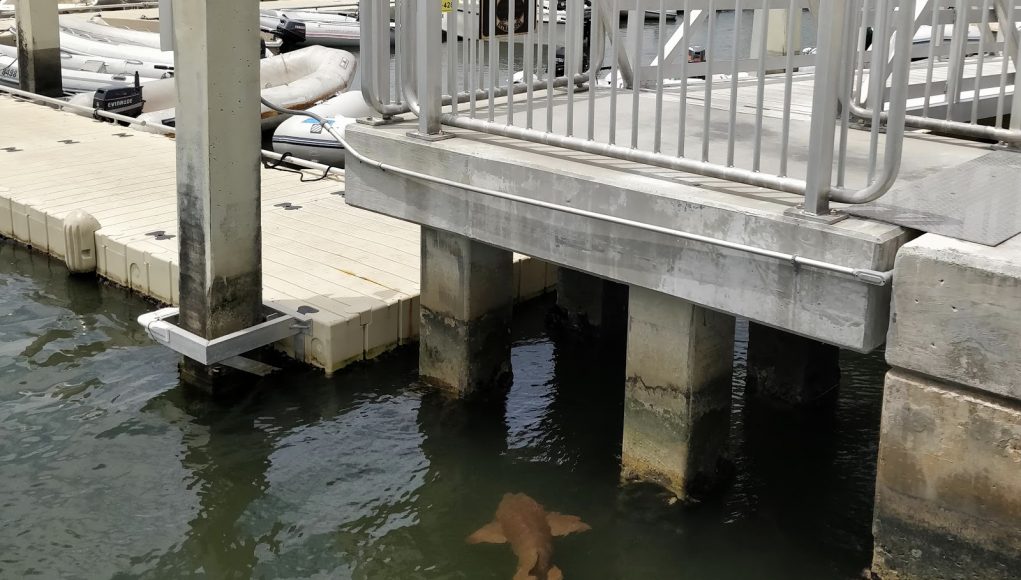It’s Shark Week, so let’s celebrate, Florida- we’re tops.
More sharks have come out of hiding in The Sunshine State and there have been fewer bites recently. The reason? There is less noise from beachgoers and boaters who are self-quarantined. But now that people are returning to reopened beaches, shark bites are expected to rise again.
As parts of Florida were under lockdowns and curfews, sharks and humans occasionally crossed paths to the delight of viewers. Near Haulover Inlet, a large shark and a group of manatees came close to a kayaker in April. Three sharks were spotted swimming close to the Miami Beach shoreline in June.
But a worldwide pandemic with sweeping lockdowns hasn’t stopped sharks from biting people and people from killing millions of sharks in fishing operations and the shark fin trade.
Florida plays a central role in both: the state has been the shark attack capital of the world for years, and it is currently the focal point of the fin trade in the United States, according to the Shark Research Institute.
While worldwide shark attacks kill eight people on average per year, some species face extinction. About 100 million are killed each year, primarily by commercial fisheries.
Sharks are mainly killed for their meat, fins, liver oil, cartilage and other body parts. They are also frequently caught up in commercial fishing operations as byproducts, especially for overfished tuna.
The Florida legislature has dawdled on a ban on shark finning, which is federally outlawed. The State House passed a Senate version of a bill in March that would outlaw the trade of shark fins in the state, but Gov. Ron DeSantis has yet to sign it into law.
“Sharks face far more dangers from us than we face from them,” said Yannis Papastamatiou, an expert on shark behavior and an FIU assistant professor of biological sciences.
Even though Florida has a high rate of shark bites, they are rarely fatal; the last fatal attack in Florida occurred in 2010. The next to last came in 2005.
“Not to trivialize it for the person who gets bit – I’ve been bit by a shark and it’s not a pleasant experience and it’s fairly dramatic- but we’re not talking about attacks or bites where people lose their lives,” said Papastamatiou.
Florida’s bites mainly come from sharks that are smaller in size compared to larger sharks found in other parts of the world that are more likely to inflict life-threatening bites, like Australia.
Glide your mouse over countries around the world to see how many shark bites have occurred there in the last 10 years. Zoom into the map to see what specific areas have had shark bite incidents. Note: Data is only of provoked and unprovoked incidents that led to bodily harm. It does not include property damage.
Shark species in Florida are diverse. Some are only three to four feet long and are shy of humans, like the bonnethead. Others, like the tiger shark, can grow up to 18 feet and are among the most dangerous to humans.
Great white sharks are seasonal visitors to Florida waters in the winter and spring. Encountering a great white is very rare and the odds of being bitten by one are akin to winning the lottery.
Shark bites in Florida have decreased compared to previous years. In the last 10 years, shark bites averaged about 25 per year but only four have occurred this year so far – one in April, one in June and two in July.
Papastamatiou expects the number of bites to remain low due to coronavirus lockdown restrictions.
“For a shark bite to happen you have to have a shark and you have to have a human and they have to meet at some point in time. If the humans aren’t there, which they’re not because we haven’t been allowed in the water or the beaches or must be in much-reduced numbers, then the probability of a bite happening obviously goes down,” said Papastamatiou.
On the other side of the world, Australia is leading in this year’s number of bites. The country has had 15 attacks since the year began, and 12 of those bites occurred after the country declared its human biosecurity emergency on March 18.
Before the popular beaches Bondi and Bronte, both near Sydney, temporarily closed on March 21, huge crowds covered the sand with sunbathers and the water with swimmers and surfers.
The two beaches reopened on April 27 with restricted time access but other beaches around Australia remained open throughout lockdowns.
“If we remove the number of people on the beaches and in the water then obviously that would probably be a good starting point for there being fewer interactions,” said Mark Bond, a shark and rays researcher and an FIU postdoctoral associate of biological sciences. “But, I mean, we’ve seen the photos on the news. Nobody is staying away from the beaches.”
As more beaches reopen around the world, it is inevitable that sharks will continue to bump into humans.
“Shark attacks are just one of those things in my mind that’s a known risk for being in the water,” said Bond.
But you are more likely to drown than you are to get bit, said Papastamatiou.
“No one blames the ocean because somebody drowns,” he said. “I think you have to just always just remember that it’s not a swimming pool, and the probability of getting bitten is never going to be zero.”
There are precautions that swimmers can take to prevent attracting a shark.
Bond and Papastamatiou advise not to swim in areas where others are fishing or cleaning fish and avoid swimming near rivers or external water source entry points that bring in murky, low-visibility water and dead fish, which attract scavenging sharks. Avoid swimming after heavy rainfall and during the dusk and dawn because that’s when sharks are most active and visibility is the poorest. To better your chances of seeing a shark before ending up too close to it, try to swim in groups.
“And obviously, if you have a profusely bleeding wound then stay out of the water,” Bond said. “Other than that, I think it’s just bad luck if you have the interaction.”
While public support for sharks and their environment has improved over the decades, the current status of the protection of overexploited sharks remains bleak, especially during the pandemic.
In May, Hong Kong broke a new record for the world’s largest shark fin trade region after a 26-ton haul of illegally smuggled shark fins worth more than $8.6 million were seized, according to a Hong Kong press release.
The fins were taken from about 38,500 sharks, mostly thresher and silky sharks, both of which are endangered. The bust was discovered after suspicious containers from Ecuador arrived in late April.
Press play on the timeline to see how many cartilaginous fishes, like sharks and rays, were captured by the top 10 capturers between 2000-2011.
Hong Kong is the world’s largest shark fin trade center, according to the Hong Kong Shark Foundation. Sale and consumption of shark fins is not illegal in the region, but the trade requires a license.
Most countries do not have a ban on finning. The act involves cutting off a shark’s fin, often while it’s still alive, before throwing it back into the ocean to die from blood loss, suffocation or predation, according to Humane Society International.
72 million sharks are annually killed for shark fin soup – an expensive delicacy in parts of Asia that is commonly eaten during celebrations like weddings.
Move your mouse over the graph to see how global reported imports and reported exports of shark fins have fluctuated in price and tons between 2000-2011.
Bond said that a third of the known 1,154 elasmobranch species – cartilaginous fish like sharks and rays – are threatened with extinction within our lifetime.
“The food web within the marine world is heavily connected so although we don’t know the exact consequences of their removal, we know that there are likely to be large consequences,” said Bond.
Papastamatiou said there is still a lot to understand about sharks before conclusions can be made about their importance and what changes to their environment would occur if they are removed due to extinction.
“If there’s anything we’ve learned from decades of conservation and ecology, generally these changes are not for the better. So we should want them around,” said Papastamatiou.
Thankfully, Papastamatiou said that despite Miami’s large, dynamic and urbanized environment, the city has a lot of sharks in its waters, which is a sign of a healthy ecosystem.
Despite the fear that some people have of sharks, Papastamatiou gave a reminder that sharks are not out to get us.
“I realize that people will always have some fear of sharks, and you should have some healthy respect,” said Papastamatiou. “But at the same time, we should be really pleased that we live in a place where we have lots of predators, which is the way it should be. These are the things that are not going terribly in these waters and we’re lucky that we can see these animals in their natural habitat.”
6 Ways to protect sharks by Anna Radinsky
































